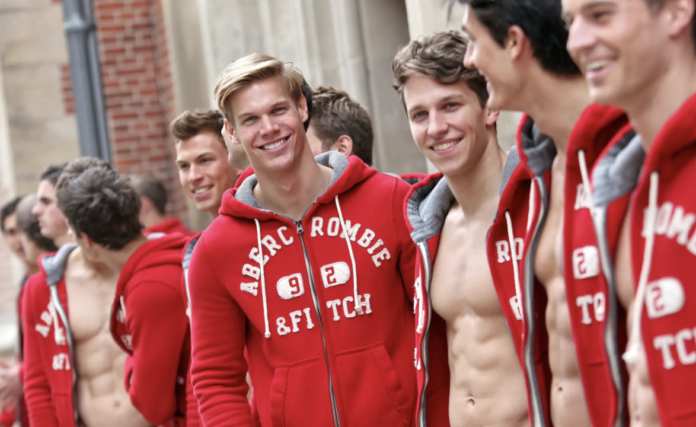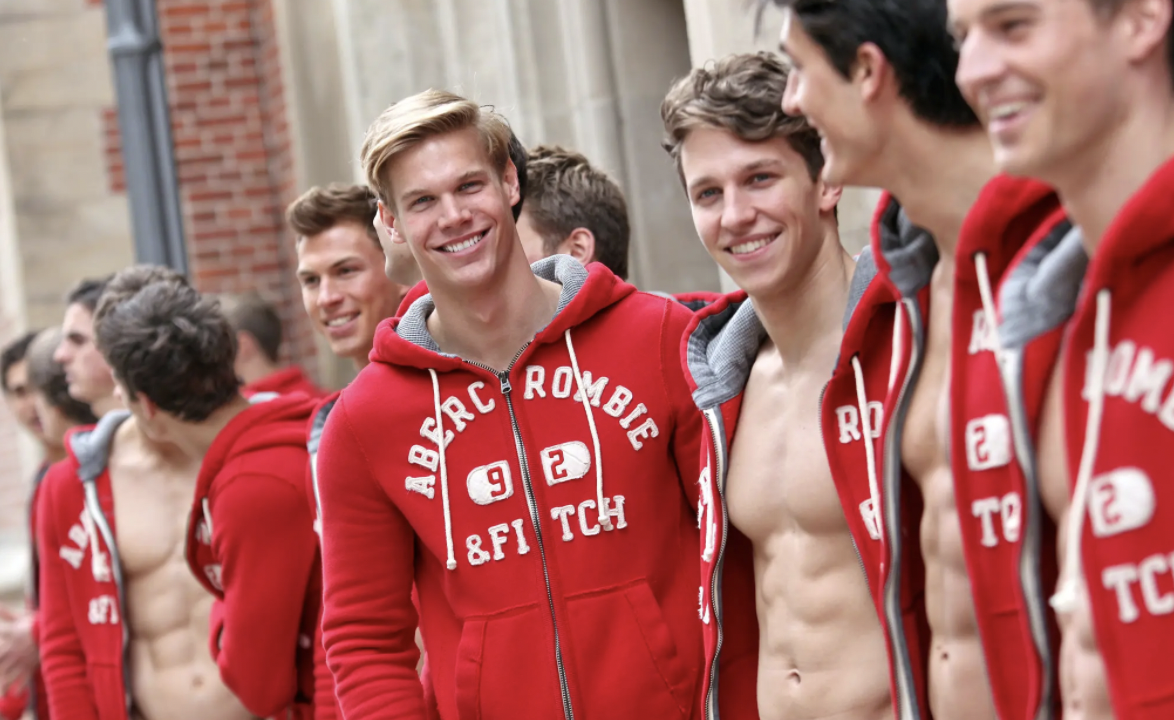I’m so “fashion”-oblivious, I once asked a stranger not very long ago why so many people wore shirts saying “Hollister”…having assumed they’d all acquired them as tourists visiting that small city in Monterey County. As it turns out, the clothier has actually threatened to sue merchants there for selling items emblazoned with their own town’s name, claiming “copyright infringement.” (Fun facts: Hollister, CA was founded in in 1868, Ohio-based brand Hollister Co. twenty-two years ago.)
The wearable kind of Hollister is a subsidiary of Abercrombie & Fitch, an outfitting and luxury goods company that’s existed in name since 1892. But it had faded, filed for bankruptcy, and been bought twice over when acquired in 1988 by “Merlin of the Mall” Les Wexner, whose L Brands corporation also encompassed Victoria’s Secret and other speciality retail chains. He handed the label to then-recent hire Mike Jeffries, who retooled A&F as a vehicle for “lifestyle apparel” that would be “the coolest brand for 18-to-22-year olds.”
It worked: Within a few years Jeffries’ minute—some employees thought micro-managerial—attention to details of store atmosphere, and star primary photographer Bruce Weber’s sexy images (largely of shirtless young male models) had made A&F a popular phenomenon. Such that this brand’s appeal transcended even its own product: As one commentator in Netflix’s new White Hot: The Rise & Fall of Abercrombie & Fitch puts it, “The clothes themselves were nothing special, but it was the label on the clothes… that was a badge of distinction.”
The “aspirational” look was variously described as “all-American sexy,” “athletic,” “natural,” “classic,” and “fraternity.” It may have signaled “preppy with money,” but was priced “not expensive enough to be out of reach” of the lower castes. Among the people who modeled in its ads before they got famous were Channing Tatum, Jennifer Lawrence, Heidi Klum, Taylor Swift and Ashton Kutcher.
That’s a pretty white list, and A&F’s image was a “super-white thing,” as some observers gradually noticed. Women were included, though the pervasive lure was chiseled young hunks, “marketing clothes… with no clothes on.” Alison Klayman’s documentary features a number of ex-employees recalling things like an in-house style book whose strict guidelines laid out a required “look” that wasn’t overtly racist, yet seemed to ban anything that might be popular amongst non-Caucasians, like braids or dreads. Also, only “goodlooking people” were hired, with no room for plus sizes or any other deviations from a heartland jock image. The few ethnic minorities employed tended to be stuck back in the stock room or given after-hours janitorial duties, keeping them from public sight.
All this served middle-aged Jeffries’ (he’s now 77) idea of catering to “the cool kids,” leading one woman here to recall her first impression as “Oh my god, they have crystalized everything I hate about high school and put it in a store.” It was a conformist ideal dependent, consciously or not, on exclusion. The shit started to hit the fan when A&F began selling T-shirts with “irreverent” slogans (like “Two Wongs Can Make It White,” over a slanty-eyed cartoon graphic) that were hugely offensive to stupefied Asian-American, Latino, and other customers, sparking protests. Later, minority employees filed successful lawsuits over discriminatory workplace practices.
The company vowed to do better, hiring diversity officers and such, though soon it became apparent that such efforts only “colored” the lowest rungs of the corporate ladder. Meanwhile, it had become an open secret that a business trading on homoeroticism was largely controlled by closeted gay men. They insisted on a “heterosexy” image while their own behavior towards young male models and others was… questionable, with a couple former poster boys here testifying to some creepy personal experiences.
Photographer-filmmaker Weber, whom I once met (an experience that can be encapsulated by the syllable “Ew”), was eventually accused of sexual assault in still-ongoing court cases. Nor did it help that Jeffries’ mentor Les Wexner was “very close” to the late Jeffrey Epstein, leading to rumors that he “supplied” the world’s soon-to-be-most-famous pedophile with Victoria’s Secret models and wannabes.
Nothing is more fickle than fashion, so it was inevitable that Abercrombie & Fitch’s moment at the center of consumer culture should have been relatively brief. But in their case, that “fall” was brutally enhanced by certain personalities’ complete obliviousness to changing times, and to their own prejudices and insensitivity. Those factors finally rendered the brand not just passe, but toxic, requiring a complete makeover under new management. (Pseudo-surfwear offshoot Hollister continues to flourish, however.)
Operating too long in a privileged bubble, those major players retreated from the public eye when that bubble burst. Needless to say, Jeffries, Weber and Wexner all “declined” to be interviewed for this documentary. As one person says in White Hot, “Exclusion was the root of their success, and [then] exclusion itself stopped being quite so cool.” A very entertaining cautionary tale, the documentary begins streaming on Netflix this Tues/19.
Other new streaming releases:
See You Then
Change is also a challenge for the two protagonists reuniting in Mari Walker’s indie drama. Naomi (Lynn Chen) and Kris (Pooya Mohseni) were a couple in college, a relationship that ended abruptly 13 years ago when Kris simply vanished—no goodbye, no follow-up communication, nothing. Now visual and performance artist Naomi teaches at the same institution they both attended, raising two young children with a husband she admits gets on her nerves. More dramatically, Kris hit a “rock bottom” of alcoholism and depression before being able to commence a gender transition that in retrospect felt inevitable.
It’s a lot to process, and as See You Then follows these characters through one evening’s course, their dynamic goes from awkwardly polite to tipsy-confidential to mutually accusative and raging. Neither of them, it turns out, were ever quite so simpatico in any subsequent coupledom. Kris is contrite for any pain inflicted, but seeks a vindicating stamp of approval for her new self. Naomi, whose fallout from their separation was worse than Kris knows, is not necessarily in a forgiving, or forgetting, mood.
Most narratives involving transpersons focus on the transition, and its impact on the person; the impacted others in their lives are just supporting players. This My Dinner With Andrea, quite compelling despite being all talk, assumes a more complex perspective. Neither central figure here is entirely sympathetic—they may continue to stimulate each other as personalities, but they’ve also scarred each other in ways that are off-putting, and may never heal. It’s a well-written and acted piece that seldom seeks to speak in generalities, limiting its reality to that of two singular, well-defined characters.
As such, it provides real food for thought—like many people we know, these two are too full of contradictions and unresolved issues to bear reducing to any feel-good inspirational pablum. Breaking Glass Pictures releases the film to DV and digital platforms Tues/19.
Bloody Oranges
Despite their clash points, the protagonists in See You Then are terribly civilized, reasonable, mature adults compared to nearly everyone in this nasty black-comedy-slash-whatever by French director and co-writer Jean-Christophe Meurisse. The unpleasantly intertwined lives that unravel here include an irresponsible geriatric couple (Olivier Saladin, Lorella Cravotta) whose notion of solving their big personal debt problem is to enter a dance contest; their son, a yuppie lawyer (Alexandre Steiger) working for the nation’s Finance Secretary (Christophe Paou); and a 16-year-old girl (Lilith Grasmug) nervously setting out to lose her virginity.
The film has specialized in a mean-spirited sort of absurdist social satire when it abruptly veers halfway from Quentin Dupieux to Michael Haneke territory with the introduction of a cartoonishly eccentric, sadistic nutcase. He’s portrayed by Fred Blin in the kind of self-congratulatory showoff turn that will have a few viewers hardee-har-ing, while the rest of us reach for the air sickness bag. From that point the content gets more deliberately offensive, while remaining snarky. Not a good combination.
Bloody Oranges is well-made, and there is one surprisingly incisive late dialogue between the lawyer and the teenage girl (who by then has been through an awful lot, emphasis on “awful”). But otherwise, it’s a gratingly smug example of France’s recent trend towards “extreme” cinema whose transgressions are all on the lurid surface, and say nothing much about anything. (Last year’s big example was the even worse Titane.) I like the outré as much as anyone, but there needs to be some wit, and/or point, and B.O. has neither—it’s got the soul of a bratty child terribly pleased that it learned a naughty word. Yes, that’ll really shock those bourgeoise! Yawn.
Dark Star Pictures is releasing to On Demand platforms Tues/19.
Freaky Futures: “Virus :32” and “Delta Space Mission”
You’ll get less guilt and more pleasure from your guilty pleasures via two newly released sci-fi films. The zombie thriller Virus :32 is something of a bounce-back from Uruguyan genre director Gustavo Hernandez, who made a couple interesting indie features before “graduating” to the bigger-budgeted, more formulaic 2018 horror You Shall Not Sleep. The simple premise is here is that irresponsible party girl Iris (Paula Silva), having forgotten that she’s to mind her own child today, reluctantly takes 8-year-old Tata to her job as a security guard at closed gym Club Neptuno. They are oblivious to the fact that a virus is already wreaking havoc outside—but when it gets inside, they soon find out.
Mother and daughter are in different parts of the facility when the infected begin to attack. Their reunion is complicated not only by the unpredictable roamings of fast-moving, strong, violent maniacs, but by Daniel Hendler as as a man whose wife is about to give birth—while she is no longer, er, herself. The “32” comes from the number of seconds that these zombies are dormant after bursts of homicidal energy, a plot gimmick not very well-explained. Nonetheless, Virus is above-average, with a virtuoso (ostensibly) single-shot opening, and one very good cat-and-mouse sequence in a locker room. As is so often the case with horror films, the buildup is actually more compelling than the payoff, but the whole still affirms Hernandez as a rising talent. Virus :32 launches on genre streaming platform Shudder Thurs/21.
Considerably wackier is the fantasy of newly restored 1984 animated feature Delta Space Mission. It was reportedly Romania’s first such effort, and they sure didn’t play it safe—101 Dalmatians, this is not. Instead, it seems to be aimed at both children and stoners, as alien journalist Alma from Planet Opp and her robo-dog Tin visit Earth in the year 3084. She is welcomed by the human staff maintaining an orbiting space station, and introduced to the HAL-like computer “Superbrain” created to operate it. Unfortunately, said machine takes one look at her buxom blue-skinned form and begins bleeping sentiments like “Alma! Mine! Mine! Forever!” It animates monsters of stone, water, and electricity to capture her, till she flees to the psychedelic swamp world Acora, where if the pursuing Superbrain doesn’t kill ya, the local flora and fauna will.
While the character animation is rather simple, not unlike the era’s TV kiddie toons, the handsome painted backgrounds and everything else are insanely colorful, adding major eye candy to an already surreal and silly wonder. Redolent of everything from Fantastic Planet and Heavy Metal to Ren & Stimpy (not to mention 2001 and Barbarella), Mircea Toia and Calin Cazan’s film will be a delightful discovery for fans of cult animation and sci-fi film alike. One wonders what the hell Romanian dictator Nicolae Ceausescu (who would be executed by his own rebelling constituents by decade’s end) made of it. Deaf Crocodile is releasing it to North American digital platforms on Tues/19.







